Charging Platform of Chess-Pad Configuration for Unmanned Aerial Vehicle (UAV)
Abstract
:1. Introduction
2. Materials and Methods
3. Charging System Design
3.1. Onboard Charging Circuit Designed (Polarity Modulator Circuit)
3.2. Landing Platform Design
- The positive–negative consecutive square copper plates are sized in such a way that their side lengths are smaller than the shortest distance between every two legs of the drone.
- The ground station’s dimensions were estimated from a repeatability test of the landing process in the same location to find the maximum area of landing error [43], which was found to be 70 × 70 cm.
- The space between each consecutive square piece in the chess platform was made to be slightly larger than the drone terminal’s spring pin contact.
4. Charging System Integration
5. Results
5.1. Charging Circuit Simulation Results
5.2. Charging Performance
- Contact losses due to the quality of the spring contact pins, copper plates, and wires. Their quality can be improved through the use of better materials such as carbon brushes and through the enlargement of the wires’ cross-section area.
- Measurement losses, which can be improved with high-efficiency sensors such as Hall-effect current and voltage sensors.
5.3. Landing Probability Simulation Result
6. Conclusions
Author Contributions
Funding
Acknowledgments
Conflicts of Interest
References
- Mahony, R.; Kumar, V. Aerial Robotics and the Quadrotor. IEEE Robot. Autom. Mag. 2012, 19, 19. [Google Scholar] [CrossRef]
- Saarinen, J.; Suomela, J.; Halme, A.; Pavlícek, J. Multientity Rescue System. IFAC Proc. Vol. 2004, 37, 35–40. [Google Scholar] [CrossRef]
- Sarunic, P.; Evans, R. Hierarchical model predictive control of UAVs performing multitarget-multisensor tracking. IEEE Trans. Aerosp. Electron. Syst. 2014, 50, 2253–2268. [Google Scholar] [CrossRef]
- Lee, B.; Kwon, S.; Park, P.; Kim, K. Active power management system for an unmanned aerial vehicle powered by solar cells, a fuel cell, and batteries. IEEE Trans. Aerosp. Electron. Syst. 2014, 50, 3167–3177. [Google Scholar] [CrossRef]
- dji. Available online: https://www.dji.com/ronin-s?site=brandsite&from=homepage (accessed on 30 July 2018).
- Lee, D.; Zhou, J.; Lin, W.T. Autonomous battery swapping system for quadcopter. In Proceedings of the 2015 International Conference on Unmanned Aircraft Systems (ICUAS), Denver, CO, USA, 9–12 June 2015; pp. 118–124. [Google Scholar] [CrossRef]
- Swieringa, K.A.; Hanson, C.B.; Richardson, J.R.; White, J.D.; Hasan, Z.; Qian, E.; Girard, A. Autonomous battery swapping system for small-scale helicopters. In Proceedings of the 2010 IEEE International Conference on Robotics and Automation, Anchorage, Alaska, 4–8 May 2010; pp. 3335–3340. [Google Scholar]
- Suzuki, K.A.; Kemper Filho, P.; Morrison, J.R. Automatic battery replacement system for UAVs: Analysis and design. J. Intell. Robot. Syst. Theory Appl. 2012, 65, 563–586. [Google Scholar] [CrossRef]
- Kemper, F.P.; Suzuki, K.A.O.; Morrison, J.R. UAV Consumable Replenishment: Design Concepts for Automated Service Stations. J. Intell. Robot. Syst. 2010, 61, 369–397. [Google Scholar] [CrossRef]
- Nugent, T.J.; Kare, J.T. Laser power for UAVs. Laser Motiv. White Paper-Power Beaming UAVs NWEN 2010, 1–9. [Google Scholar]
- Ouyang, J.; Che, Y.; Xu, J.; Wu, K. Throughput Maximization for Laser-Powered UAV Wireless Communication Systems. In Proceedings of the 2018 IEEE International Conference on Communications Workshops (ICC Workshops), Kansas City, MO, USA, 20–24 May 2018; pp. 1–6. [Google Scholar]
- Laser Beaming Recharges UAV in Flight. 2018. Available online: https://www.popularmechanics.com/flight/drones/a7966/how-it-works-laser-beaming-recharges-uav-in-flight-11091133/ (accessed on 28 July 2012).
- Brown, W.C. Experiments Involving a Microwave Beam to Power and Position a Helicopter. IEEE Trans. Aerosp. Electron. Syst. 1969, 5, 692–702. [Google Scholar] [CrossRef]
- Nugent, J.T.J.; Kare, J.T. Laser power beaming for defense and security applications. In Proceedings of the SPIE 8045, Unmanned Systems Technology XIII, 804514, Orlando, FL, USA, 23 May 2011. [Google Scholar] [CrossRef]
- Ireland, M.L.; Anderson, D. Optimisation of Trajectories for Wireless Power Transmission to a Quadrotor Aerial Robot. J. Intell. Robot. Syst. 2018, 95, 567–584. [Google Scholar] [CrossRef] [Green Version]
- Kurs, A.; Karalis, A.; Moffatt, R.; Joannopoulos, J.D.; Fisher, P.; Soljačić, M. Wireless Power Transfer via Strongly Coupled Magnetic Reconances. Science 2007, 317, 83–86. [Google Scholar] [CrossRef] [Green Version]
- Karalis, A.; Joannopoulos, J.D.; Soljacicb, M. Efficient wireless non-radiative mid-range energy transfer. Ann. Phys. 2008, 323, 34–48. [Google Scholar] [CrossRef] [Green Version]
- Fu, M.; Zhang, T.; Ma, C.; Zhu, X. Efficiency and Optimal Loads Analysis for Multiple-Receiver Wireless Power Transfer Systems. IEEE Trans. Microw. Theory Tech. 2015, 63, 801–812. [Google Scholar] [CrossRef]
- Zhang, W.; Mi, C.C. Compensation Topologies of High-Power Wireless Power Transfer Systems. IEEE Trans. Veh. Technol. 2016, 65, 4768–4778. [Google Scholar] [CrossRef]
- Bi, Z.; Kan, T.; Mi, C.C.; Zhang, Y.; Zhao, Z.; Keoleian, G.A. A review of wireless power transfer for electric vehicles: Prospects to enhance sustainable mobility. Appl. Energy 2016, 179, 413–425. [Google Scholar] [CrossRef] [Green Version]
- Henze, C.P.; Nicholls, K.E. Method and apparatus for charging a plurality of electric vehicles. U.S. Patent No. 5,803,215, 8 September 1998. [Google Scholar]
- Song, C.; Kim, H.; Kim, Y.; Kim, D.; Jeong, S.; Cho, Y.; Lee, S.; Ahn, S.; Kim, J. EMI Reduction Methods in Wireless Power Transfer System for Drone Electrical Charger Using Tightly Coupled Three-Phase Resonant Magnetic Field. IEEE Trans. Ind. Electron. 2018, 65, 6839–6849. [Google Scholar] [CrossRef]
- Joseph, B.A.; Graves, J.L.; Olson, T.B. System and method for managing electromagnetic interference for electronic devices. U.S. Patent No. 10,459,874, 29 October 2019. [Google Scholar]
- Covic, G.A.; Boys, J.T. Inductive Power Transfer. Proc. IEEE 2013, 101, 1276–1289. [Google Scholar] [CrossRef]
- Shinohara, N. Power without wires. IEEE Microw. Mag. 2011, 12, S64–S73. [Google Scholar] [CrossRef]
- Campi, T.; Cruciani, S.; Feliziani, M. Wireless Power Transfer Technology Applied to an Autonomous Electric UAV with a Small Secondary Coil. Energies 2018, 11, 352. [Google Scholar] [CrossRef] [Green Version]
- Campi, T.; Cruciani, S.; Maradei, F.; Feliziani, M. Near-Field Reduction in a Wireless Power Transfer System Using LCC Compensation. IEEE Trans. Electromagn. Compat. 2017, 59, 686–694. [Google Scholar] [CrossRef]
- Campi, T.; Cruciani, S.; De Santis, V.; Feliziani, M. EMF Safety and Thermal Aspects in a Pacemaker Equipped With a Wireless Power Transfer System Working at Low Frequency. IEEE Trans. Microw. Theory Tech. 2016, 64, 1–8. [Google Scholar] [CrossRef]
- Jawad, A.M.; Nordin, R.; Gharghan, S.K.; Jawad, H.M.; Ismail, M. Opportunities and Challenges for Near-Field Wireless Power Transfer: A Review. Energies 2017, 10, 1022. [Google Scholar] [CrossRef]
- Nair, V.V.; Choi, J.R. An Efficiency Enhancement Technique for a Wireless Power Transmission System Based on a Multiple Coil Switching Technique. Energies 2016, 9, 156. [Google Scholar] [CrossRef] [Green Version]
- Feliziani, M.; Campi, T.; Cruciani, S.; Maradei, F.; Grasselli, U.; Macellari, M.; Schirone, L.; Robust, M.F. LCC compensation in wireless power transfer with variable coupling factor due to coil misalignment. In Proceedings of the 2015 IEEE 15th International Conference on Environment and Electrical Engineering (EEEIC), Rome, Italy, 10–13 June 2015; pp. 1181–1186. [Google Scholar]
- Campi, T.; Dionisi, F.; Cruciani, S.; De Santis, V.; Feliziani, M.; Maradei, F. Magnetic field levels in drones equipped with Wireless Power Transfer technology. In Proceedings of the 2016 Asia-Pacific International Symposium on Electromagnetic Compatibility (APEMC), Shenzhen, China, 18–21 May 2016; Volume 1, pp. 544–547. [Google Scholar] [CrossRef]
- Choi, C.H.; Jang, H.J.; Lim, S.G.; Lim, H.C.; Cho, S.H.; Gaponov, I. Automatic wireless drone charging station creating essential environment for continuous drone operation. In Proceedings of the 2016 International Conference on Control, Automation and Information Sciences (ICCAIS), Ansan, Korea, 27–29 October 2016; pp. 132–136. [Google Scholar] [CrossRef]
- Bin Junaid, A.; Lee, Y.; Kim, Y. Design and implementation of autonomous wireless charging station for rotary-wing UAVs. Aerosp. Sci. Technol. 2016, 54, 253–266. [Google Scholar] [CrossRef]
- Bin Junaid, A.; Konoiko, A.; Zweiri, Y.; Sahinkaya, M.N.; Seneviratne, L.D. Autonomous Wireless Self-Charging for Multi-Rotor Unmanned Aerial Vehicles. Energies 2017, 10, 803. [Google Scholar] [CrossRef]
- Almassri, A.M.M.; Hasan, W.Z.W.; Ahmad, S.A.; Ishak, A.J. A sensitivity study of piezoresistive pressure sensor for robotic hand. In RSM 2013 IEEE Regional Symposium on Micro and Nanoelectronics; Institute of Electrical and Electronics Engineers (IEEE): New York, NY, USA, 2013; pp. 394–397. [Google Scholar]
- Schmidt, H. Method and apparatus for charging and/or charge exchange between a plurality of series connected energy storage devices. U.S. Patent 5,767,660, 16 June 1998. [Google Scholar]
- Magaña, E.J.C.; Esteban-Campillo, D.; Jiménez, D.S.; Maza, I.; Caballero, F. Device and method for use with unmanned aerial vehicles. U.S. Patent No. 9,481,458, 1 November 2016. [Google Scholar]
- Sidek, M.; Hasan, W.; Kadir, M.; Shafie, S.; Radzi, M.; Ahmad, S.; Marhaban, M. GPS based portable dual-axis solar tracking system using astronomical equation. In 2014 IEEE International Conference on Power and Energy (PECon); Institute of Electrical and Electronics Engineers (IEEE): New York, NY, USA, 2014; pp. 245–249. [Google Scholar]
- Leonard, J.; Savvaris, A.; Tsourdos, A. Energy Management in Swarm of Unmanned Aerial Vehicles. J. Intell. Robot. Syst. 2014, 74, 233–250. [Google Scholar] [CrossRef]
- Cisek, K.; Zolich, A.; Klausen, K.; Johansen, T.A. Ultra-wide band Real time Location Systems: Practical implementation and UAV performance evaluation. In Proceedings of the 2017 Workshop on Research, Education and Development of Unmanned Aerial Systems (RED-UAS), Linköping, Sweden, 3–5 October 2017; pp. 204–209. [Google Scholar] [CrossRef] [Green Version]
- Shafie, S.; Kawahito, S.; Halin, I.A.; Hasan, W.Z.W. Non-Linearity in Wide Dynamic Range CMOS Image Sensors Utilizing a Partial Charge Transfer Technique. Sensors 2009, 9, 9452–9467. [Google Scholar] [CrossRef]
- Al-Obaidi, M.; Mustafa, M.A.; Hasan, W.Z.W.; Azis, N.; Sabry, A.H.; Ang, S.; Hamid, Z.H.A. Efficient Charging Pad for Unmanned Aerial Vehicle Based on Direct Contact. In Proceedings of the 2018 IEEE 5th International Conference on Smart Instrumentation, Measurement and Application (ICSIMA), Songkla, Thailand, 28–30 November 2018; pp. 1–5. [Google Scholar] [CrossRef]
- Jonah, O.; Georgakopoulos, S.V. Wireless Power Transfer in Concrete via Strongly Coupled Magnetic Resonance. IEEE Trans. Antennas Propag. 2012, 61, 1378–1384. [Google Scholar] [CrossRef]
- Jung, S.; Lee, T.; Mina, T.; Ariyur, K.B. Inductive or Magnetic Recharging for Small UAVs. SAE Tec. Paper Ser. 2012. [Google Scholar] [CrossRef]
- Sabry, A.H.; Hasan, W.Z.W.; Kadir, M.A.; Radzi, M.A.M.; Shafie, S. DC-based smart PV-powered home energy management system based on voltage matching and RF module. PLoS ONE 2017, 12, e0185012. [Google Scholar] [CrossRef] [Green Version]
- Sabry, A.H.; Hasan, W.Z.W.; Zainal, M.; Amran, M.; Shafie, S. Alternative Solar-Battery Charge Controller to Improve System Efficiency. Appl. Mech. Mater. 2015, 785, 156–161. [Google Scholar] [CrossRef]

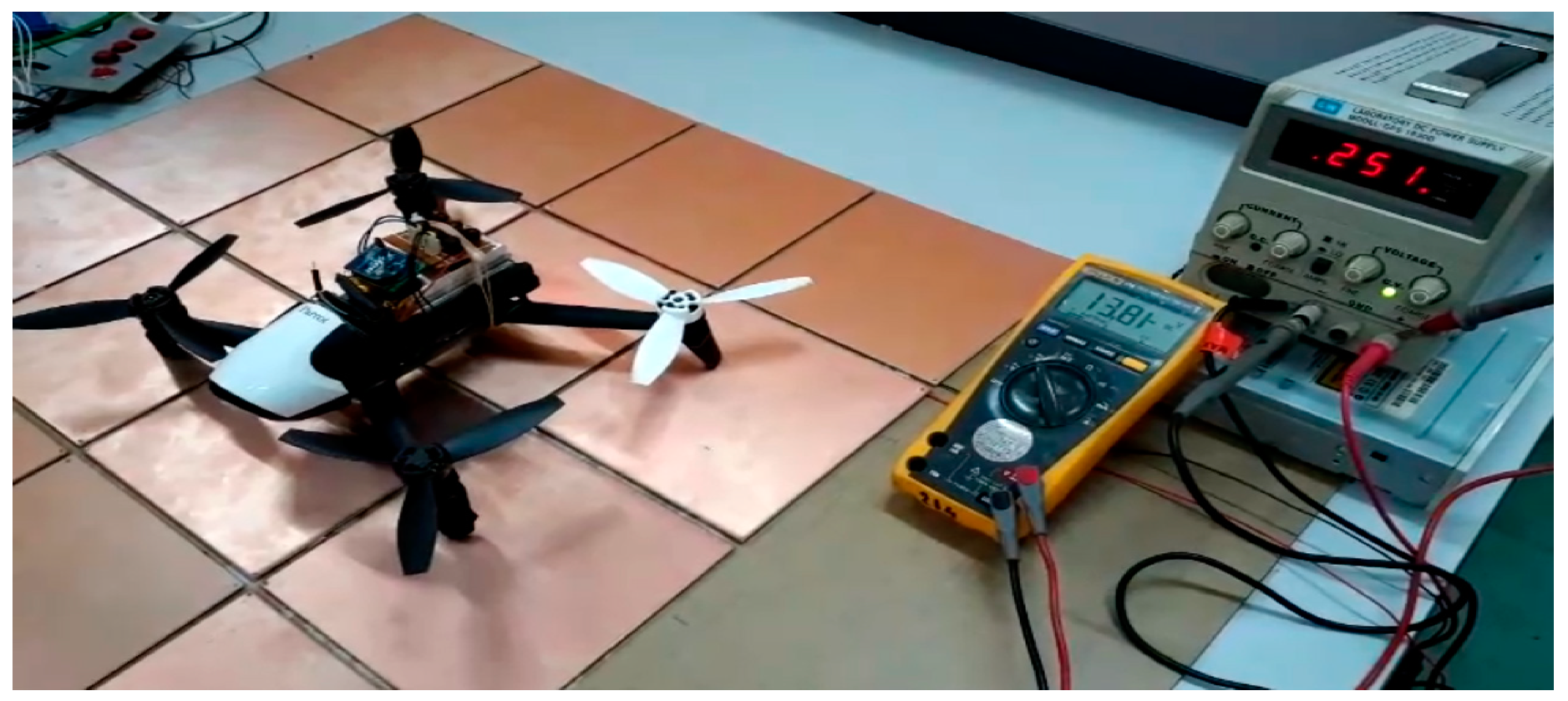

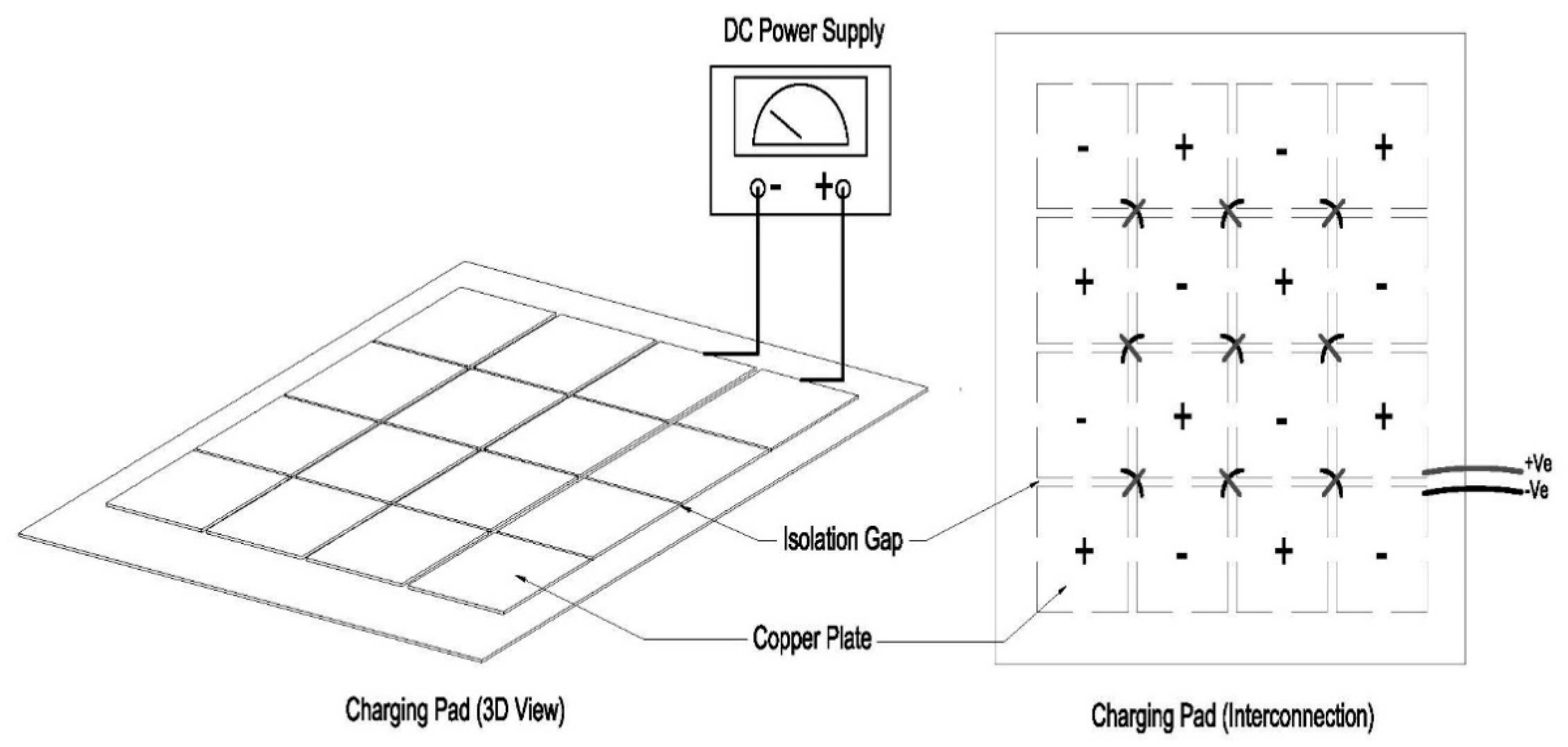
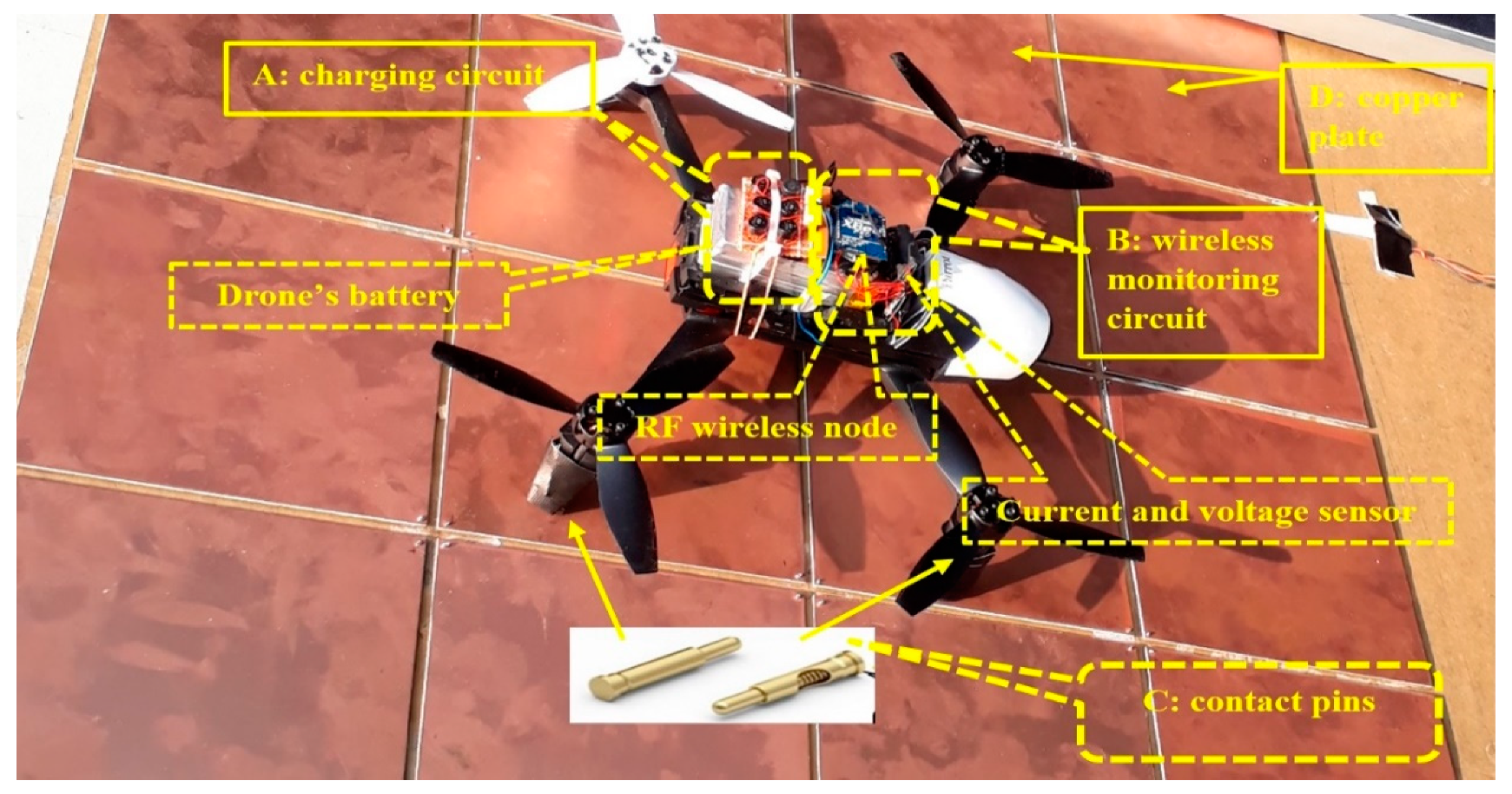
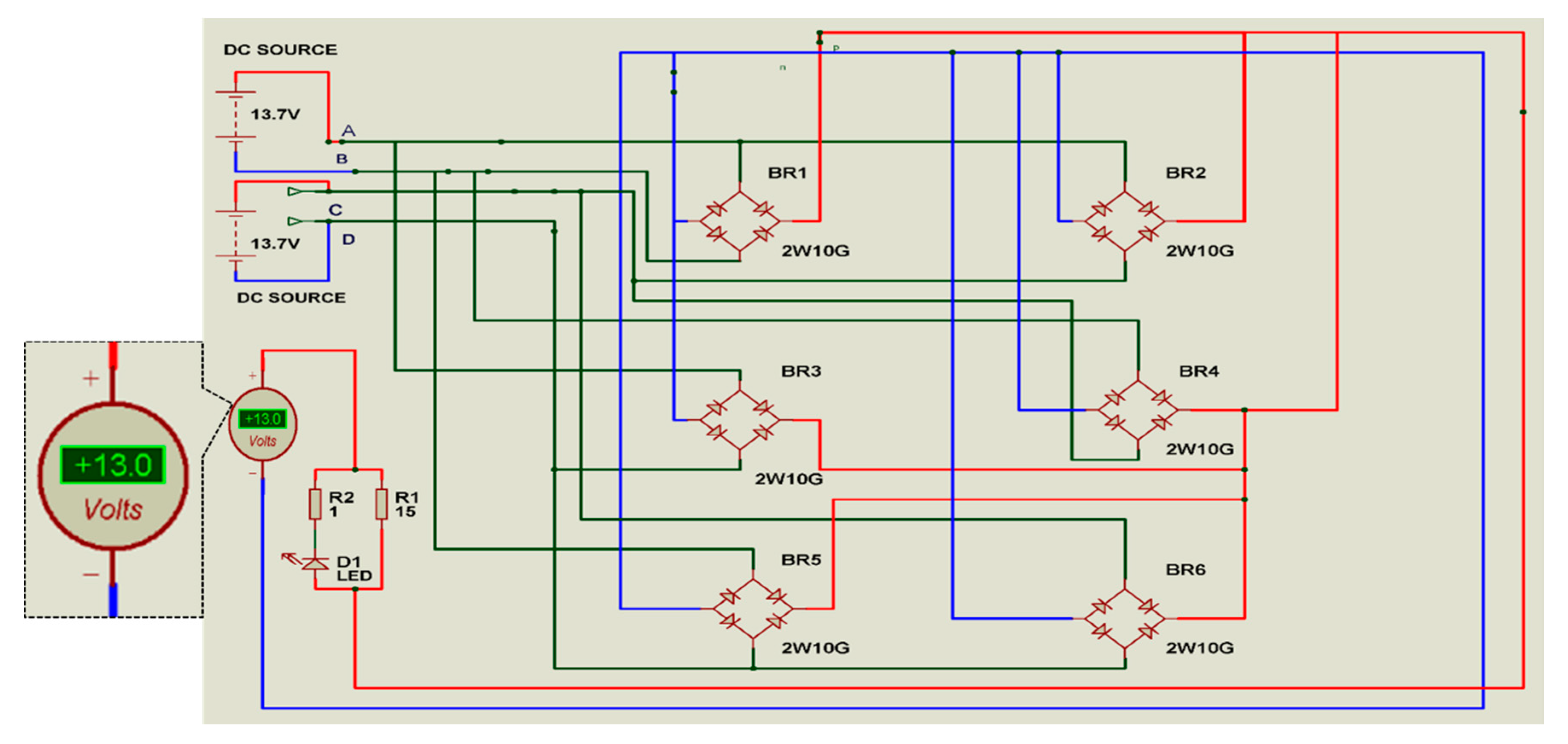
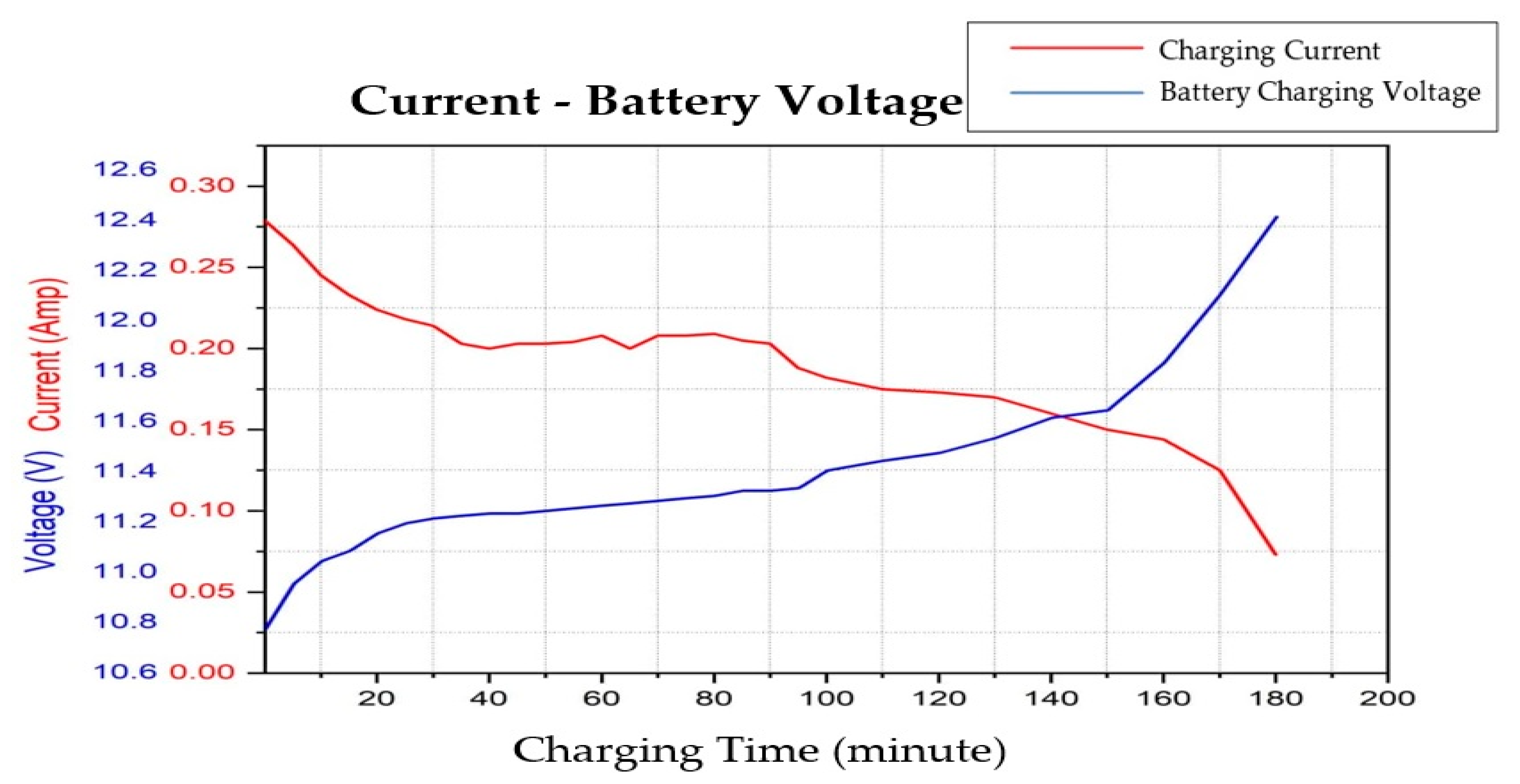
| Drone ID | Pin A | Pin B | Pin C | Pin D | Charging Status |
|---|---|---|---|---|---|
| 0 | − | + | + | − | Charging |
| 1 | − | − | − | − | Not Charging |
| 2 | − | − | + | − | Charging |
| 3 | − | − | − | + | Charging |
| 4 | 0 | − | − | + | Charging |
| 5 | + | − | − | + | Charging |
| 6 | + | + | − | − | Charging |
| 7 | + | + | + | + | Not Charging |
| 8 | − | − | + | + | Charging |
| 9 | + | − | − | + | Charging |
| 10 | + | − | − | + | Charging |
| 11 | + | + | 0 | − | Charging |
| 12 | − | + | − | − | Charging |
| 13 | 0 | − | + | + | Charging |
| 14 | + | + | − | − | Charging |
| 15 | − | + | + | − | Charging |
| Charging Efficiency, ƞ (%) | Method | Reference |
|---|---|---|
| 88.42 | Contact Charging | This Work |
| 40–50 | Wireless Power Transfer | [44] |
| 52 | Wireless Power Transfer | [17] |
| 76 | Wireless Power Transfer | [26] |
| 65 | Wireless Power Transfer | [33] |
| >50 | Wireless Power Transfer | [34] |
| 75 | Wireless Power Transfer | [35] |
| 13.33 | Inductive Charging | [45] |
| Details of Design | Number of Plates | Charging Probability Percentage (%) |
|---|---|---|
| 10 × 10 cm | 36 | 57 |
| 12 × 12 cm | 25 | 55 |
| 14 × 14 cm | 16 | 69 |
| 16 × 16 cm | 16 | 76 |
| 18 × 18 cm | 9 | 71 |
Publisher’s Note: MDPI stays neutral with regard to jurisdictional claims in published maps and institutional affiliations. |
© 2020 by the authors. Licensee MDPI, Basel, Switzerland. This article is an open access article distributed under the terms and conditions of the Creative Commons Attribution (CC BY) license (http://creativecommons.org/licenses/by/4.0/).
Share and Cite
Al-Obaidi, M.R.; Wan Hasan, W.Z.; Mustafa, M.A.; Azis, N. Charging Platform of Chess-Pad Configuration for Unmanned Aerial Vehicle (UAV). Appl. Sci. 2020, 10, 8365. https://doi.org/10.3390/app10238365
Al-Obaidi MR, Wan Hasan WZ, Mustafa MA, Azis N. Charging Platform of Chess-Pad Configuration for Unmanned Aerial Vehicle (UAV). Applied Sciences. 2020; 10(23):8365. https://doi.org/10.3390/app10238365
Chicago/Turabian StyleAl-Obaidi, Mohammed Rameez, Wan Zuha Wan Hasan, Mohd Amrallah Mustafa, and Norhafiz Azis. 2020. "Charging Platform of Chess-Pad Configuration for Unmanned Aerial Vehicle (UAV)" Applied Sciences 10, no. 23: 8365. https://doi.org/10.3390/app10238365







